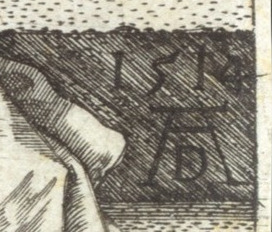

Irène de Palacio
4 déc. 2025



Dernière mise à jour : 1 mai 2023

Albrecht Dürer - Melencolia I, 1514
Extract from :
"The name for the engravings is taken from the motto that appears on a banderole. Actually, the motto is “MELENCOLIA §I”, with the symbol §, a fancy S, in a lighter
style than the rest.

Melancholia is the transliterated Greek for melancholy and black bile. One Latin form is melancolicus; The German is Melancholie. The Italian was Malinconia. Dürer himself uses the etymologically reasonable form "Melancolia" in a title-page woodcut of 1503.
In no language is the word melencolia, a spelling odd even for Dürer. The spelling of the time was so variable that we cannot be sure, but this spelling may be imposed on the overt message by a covert one that Dürer wished both to record and conceal in an anagram. The encodings we have already found, the misspelling, and the cryptic appended symbols §I suggest this possibility.
Agrippa could well have put anagrams, gematria, and magic squares into Dürer’s mind. They are all in his Occult Philosophy. They are also among the techniques used to squeeze new meanings out of old texts in the Baraita of Thirty-Two Rules of Rabbi Eliezer ben Jose the Galilean, who flourished in the second half of the second century C.E. and was cited importantly in later years. Such lore became more accessible to Florentine Neo-Platonists like Agrippa, an active Hebraist, when Jews expelled from Spain in 1492 settled in Florence.
In any case, by the 16th century letter-permutation was a standard way to protect intellectual property. The Royal Society and the system of scientific archives were still over a century in the future. Writers of the time who solved an important problem could not guard their intellectual property by publishing or patenting. Some protected their priority by permuting the letters of their solution and publishing the result together with the problem.
Earlier Roger Bacon scrambled the formula for gunpowder in this way in order to prevent the proliferation of this terrible weapon. Later Galileo would scramble his discoveries of the phases of Venus and the rings of Saturn.
Mathematicians scrambled their theorems. The resulting meaningless jumble of letters declared on its face that it was a cipher. Sometimes it was misconstrued by a false rearrangement. In the next degree of concealment, the scrambled letters themselves spell out a cover message, the anagram. This can hide not only a message but even the existence of that message.
MELENCOLIA I does this well. Only the cover message has been read in recent centuries as far as I know. I unscrambled the anagram as soon as I began to work at deciphering the engraving, as follows. Since Panofsky declared the engraving autobiographical, I tentatively supposed that the motto represented Dürer himself. To see how he might describe himself graphically I went to his coat-of-arms (1490, 1523).
The 1523 version centers his famous monogram and the year above his coat-of-arms.

Albrecht Dürer - Coat of Arms of the House of Dürer, 1523
Next below them come clichés one finds in any dictionary of heraldry :
A blackamoor for heroic action by an ancestor in the Crusades ;
Eagle wings for fame and glory ;
A closed helmet in full profile for the estate of esquire, the lowest.
A shield below these clichés bears an image specific to the family.

I read this as follows.
Coats-of-arms usually display the pride of the family, some great personal accomplishment. To proclaim his greatest talent, engraving, Dürer could simply have drawn a burin on the shield, or the word “burin” itself. But the Latin for burin is caelum.
This is also the ordinary word for “the sky, ” “heaven,” and “the heavens.” It has the same root as our “celestial.” Caelo means both the noun (in) Heaven and the verb (I) engrave. The root seems to mean both swelling and hole.
• The Dürer coat-of-arms is both an ideogram for “Gateway in Heaven” and a rebus
for “I engrave the gateway”.
“Gateway in Heaven” was a well-known metaphor for the Roman Church itself. A person of the time might take the Dürer coat-of-arms not as a sacrilegious display of ego but as a pious reaffirmation that we are made in the image of God. But it can also serve as a banner of Humanism: the Gateway to Heaven is open to us all. Gates of Heaven open again and again in MELENCOLIA I itself.
The Dürer monogram AD, exhibited at the top center of the 1523 coat-of-arms and at the bottom right corner of MELENCOLIA I, is one of them. It seems at first to be a pun on Anno Domini.




Now one can see that it is also an ideogram.
The flat-topped A is a gateway as well as a letter. The legs of the A are the uprights of the gateway. The lintel sits on them and connects them. A stiffener just beneath the lintel is the crossing of the A, rather high for an A but proper for a gateway.
The D between the uprights of the A echoes the Doors between the uprights of the Gateway in the Dürer coat-of-arms. In his coat-of-arms he symbolized his holy art by the punning caelo rebus.
As soon as I found this pun I checked to see whether CAELO fits into MELENCOLIA, as it does.
The leftover letters then spell out LIMEN, commonly meaning gateway, a near-synonym for “Dürer,” and good description of the gateway in the Dürer coat-of-arms.
It also means gate, doorway, threshold, lintel, walls, house, home, boundary path, and limit, according to context.
Unscrambled, the first word of the motto becomes LIMEN CAELO , “Gateway to Heaven”, a description of the Dürer coat-of-arms.
(...)
The hidden phrase also applies to the dim archway in the heavens that frames the motto, and to other elements that we take up later.

These multiple points of contact between the anagram and the engraving suggested that I had read it correctly.
(...)"
Source :




